2022.07.04.10
Files > Volume 7 > Vol 7 No 4 2022
A study comparing the oncogenic microRNA-21-5p and the CA15-3 characteristics as an effective tumor marker in breast cancer patients from Iraq.
Ruwaidah A.R. Abbas 1*, Ismail H. Aziz 2.
1 University of Fallujah, College of Applied Science, Department of Pathological Analysis. Iraq.
2 University of Baghdad, Institute of Genetic engineering and Biotechnology for postgraduate studies. Iraq.
* Correspondence: [email protected]
Available from: http://dx.doi.org/10.21931/RB/2022.07.04.10
ABSTRACT
Breast cancer (BC) is a genetic disease in the mammary glands' ducts and lobules, with ductal cancers comprising most of the malignancies. Biomarkers can provide an assessment of cancer diagnosis and prediction. The study aims to compare the expression of serum (miR-21-5p) and CA 15-3 expression in the Iraqi population as more efficient biomarkers, then checked MiRNA-21 main characters as a biomarker comparison with (CA15-3) levels. Circulating serum miRNA-21 expression was measured using (the quantitative Real Time-PCR technique) in 50 patients at various stages of breast cancer compared to 27 healthy controls. Meanwhile, CA 15-3 levels were quantified using electro-chemo luminescence immunoassay (ECLIA) methods. The results show the expression of miRNA-21 and the concentration of CA15-3 increased significantly (p>0.01) in patients as compared to control, but the higher median level of MiRNA-21 than of CA15-3. The ROC curve analysis shows that the accuracy, Overall Model Quality, AUC, sensitivity and specificity of miRNA-21 as a biomarker is much higher than the CA 15-3. In conclusion, miRNA-21 may fill the gap that CA 15-3 still lacks in detecting breast cancer at an early stage.
Keywords: Breast cancer, microRNA-21, CA15-3, gene expression, RT-q PCR.
INTRODUCTION
Breast cancer is the most common malignancy among women globally 1 . Breast cancer is the primary cause among women and the leading cancer-related female mortality in Iraq 2. The malignancy of the breast tissues results from the uncontrolled proliferation of breast ductal and lobular epithelial cells, with ductal cancers accounting for most cases 3. Early detection and treatment have been proven to be the most effective techniques, and early screening programs have dramatically improved BC outcomes and survival rates four. Many studies routinely measured serologically CA 15-3 frequently raised in BC patients 5. There is low sensitivity and specificity of the CA15-3 marker, so we need to develop a more sensitive approach for early breast cancer diagnosis 6. The key to delivering preventive healthcare is the clinical novel assays that enable early disease detection. Such assays are based on biomarkers such as (microRNAs) from tissue or liquid biopsy 7. Circulating MiRNAs are emerging as new diagnostic and prognostic biomarkers for BC; there help predict tumor response to specific chemotherapeutic drugs 8. MicroRNA-21 has been described as one of the most significantly up-regulated miRNAs in human breast cancer regardless of previous exposure to chemotherapy treatment which reinforces its role as an "oncomiR" and a potential biomarker 9. The study aims to analyze the expression quantity of serum (miR-21-5p) and compare it with one of the most widely used serum markers (CA15-3), then check sensitivity, specificity, accuracy, quality and discrimination power comparison for both miRNA-21 and CA15-3 markers.
MATERIALS AND METHODS
The study enrolled from November 2021 to January 2022 in the laboratories of the Baghdad university's genetic engineering and biotechnology institute. The samples were collected from patients who were first diagnosed with breast cancer and consulted Al-Andalus Specialist Oncology Hospital in Baghdad and Al Anbar Specialized Center for Cancer treatment.
Venous blood was taken from patients and healthy groups five milliliters (mL); all patients diagnosed with primary BC by histology were placed in gel tubes for 30 minutes at room temperature, then centrifuged for 10 minutes to obtain serum. The separated sera were divided into two tubes, one for biochemical assay and the other for molecular assay.
Biochemical assay measurement of Serum ( CA15.3 ) concentration
The "ECLIA" electrochemiluminescence immunochemical assay technology is designed for the quantitative measurement of CA 15-3 in human serum, obtained from an automated quantification process using the COBAS ECLIA immunoassay analyzer (COBAS E 411) (Roche Diagnostics, Basel, Switzerland). This procedure was performed according to Elecsys CA 15-3 II ECLIA kit 10.
Protocol of microRNA extraction from the serum blood samples
Total RNA, including microRNA, was isolated from the sample according to the protocol of TRIzol™ Reagent, 0.2 mL of chloroform add to the aqueous phase containing RNA, 0.5 mL of isopropanol was added for RNA precipitated as white gel-like Pellet, 0.5mL of 70% ethanol was added for RNA washing. Finally, Pellet was rehydrated in 50μl of Nuclease Free Water and then incubated in a water bath at 55–60°C for 10–15 minutes.
Reverse Transcription for complementary DNA (c DNA) synthesis
RNA sample 4 µl was mixed with 1 µl stem-loop RT primers of miR-21. The Primers for miR-21 were designed in this study using (The Sanger Center miR database Registry) and 27. The cDNAs were synthesized by reverse transcription of miRNA using a script cDNA synthesis kit, "5GTTGGCTCTGGTGCAGGGTCCGAGGTATTCGCACCAGAGCCAACCAACA 3".
Quantitative Real-Time Polymerase Chain Reaction (RT-q PCR)
The PCR master mix preparation is shown in table (1), and Real-Time PCR Program, and thermal cycling conditions for miR-21, are in table (2).
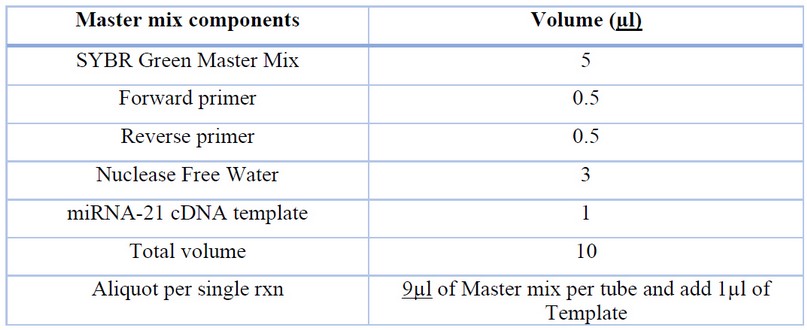
Table 1. The PCR master mix preparation for miR-21

Table 2. PCR condtitions.
Statistical analysis
The Statistical Analysis System- SAS (2012) program was used to detect the effect of different factors on study parameters. T-test used to compare between means. The diagnostic accuracy, sensitivity and specificity were performed using the (ROC) curve analysis. The cut-off values and area under the ROC curve (AUC) were then determined were done using (SPSS) package software version 24 11
RESULTS
Molecular Analyses of circulating miRNA-21 expression level.
The RT-q PCR results for miR-21 were analyzed by the relative quantification of gene expression levels (folding changes) based on the (Ct) values. All patients show a high level of miR-21 level which was significantly elevated (**P>0.01) among BC patients (5.27 times increase) than healthy control (1.00) Table (3).
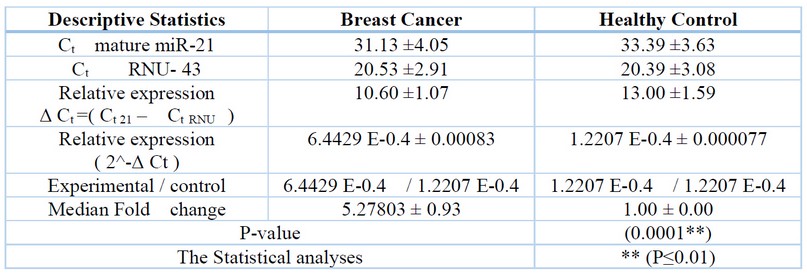
Table 3. Comparison expression of miRNA21 between both study groups.
Biochemical analyses of CA 15-3 concentration Level
The mean ± SEM of the serum CA15-3 concentration was (23.17 ± 0.78 U/ml) in the BC group and (9.15 ± 0.70 U/ml) in the control group shown in Table 4.
The significant increase in the mean values of CA15-3 concentration in breast cancer patients for (2.36 times increase) compared to control groups that gave a high significantly statically analysis as (**p>0.01) in BC patients.

Table 4. Mean serum concentration of CA15-3 between study groups
The Diagnostics Performance of miRNA-21 marker in the Studied Groups.
Receiver operator characteristics curve (ROC) analysis of miRNA-21 in the serum of breast cancer patients recorded high sensitivity (96%) and specificity (92.6%) at a cut-off value of (1.04) with high AUC values as (0.981) in discriminately the breast cancer patients. Table (5 ) & Fig. ( 1).

Table 5. ROC curve analysis of miRNA-21 to distinguish between BC and HC.
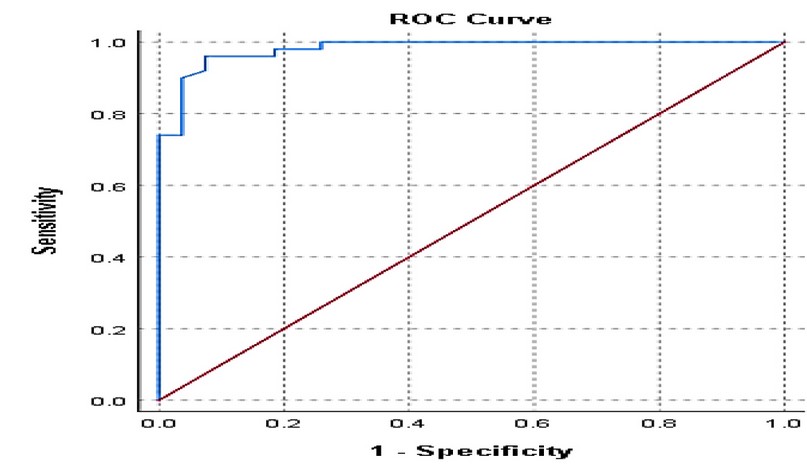
Figure 1. MiRNA-21 Sensitivity and Specificity by ROC curve.
The Diagnostics Performance of CA15-3 marker in the Studied Groups.
Receiver Operator of Characteristics (ROC) curves analysis of serum CA 15-3 was found with low sensitivity and specificity of (72% and 70.4%) respectively, at the low area under the curve (AUC= 0.563 ) and already known cut-off ( 25 U/mL ).

Table 6. ROC curve of CA 15-3 in distinguishing between breast cancer and healthy subjects.
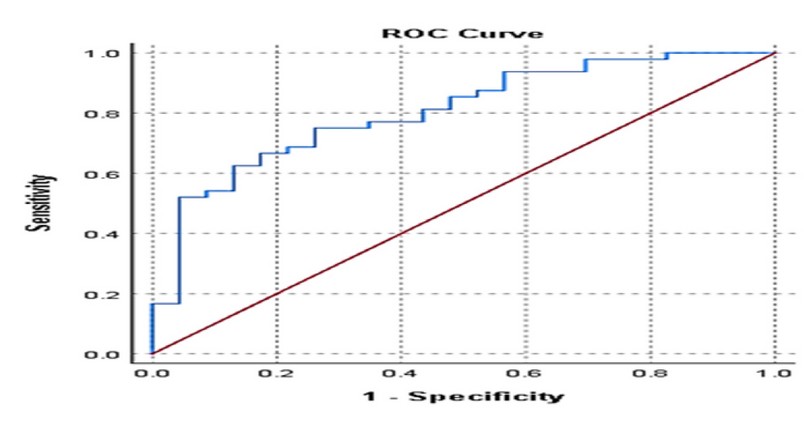
Figure 2. CA 15-3 Sensitivity and Specificity by ROC curve.
Comparison of miRNA-21 and CA15-3 and their diagnostic accuracy and discrimination power (AUC).
The calculation of diagnostic accuracy for each marker and the value of area under the curve (AUC) as a discrimination power for the selected miRNA-21 compared to the AUC value of the traditional BC biomarker CA15-3 by using receiver operating characteristic (ROC) curve analyses that show in the table ( 7).

Table 7. Diagnostic accuracy and AUC of both circulation biomarkers.
The diagnostic accuracy of both biomarkers was calculated; among the analyses molecules, the miR-21-5p marker showed the highest diagnostic accuracy (0.94) than the low diagnostic accuracy (0.71) of the CA15-3 marker.
The Statistical analyses were carried out using (ROC-AUC) curve to determine the discrimination biomarkers power of both markers to discriminate BC patients from HC groups; we compared the area value under the curve (AUC) of both markers. The results show that the miRNA-21 had significantly higher AUC values of discriminately the BC group (0.981), while a lower AUC of CA15-3 is recorded only (0.563). Show in table (7) & fig. (3) & fig. (4).
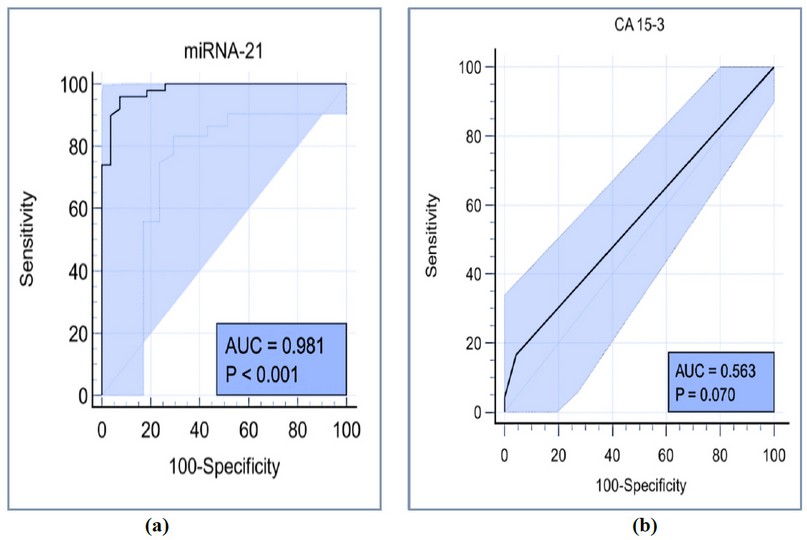
Figure 3. This figure includes: (a) the AUC value of MiRNA-21-5P ; (b) the AUC value of CA 15-3
Comparison of miRNA-21 and CA15-3 Overall Model Quality.
The Overall Model Quality of tumor biomarkers is represented in the chart that generally measures the model quality of molecular miRNA-21 and biochemical CA15-3 biomarkers samples and median expression level in breast cancer group folds in all study groups ( patients and control ).
The result of MiRNA-21 model quality was significantly higher at ( 0.95 ) than CA15-3 with ( 0.70 ), shown in tables ( 8 ) and ( 9 ) & figure ( 5 ).

Table 8. Statically database for study samples processing summary.

Table 9. Statically database for sample model quality in both biomarkers.
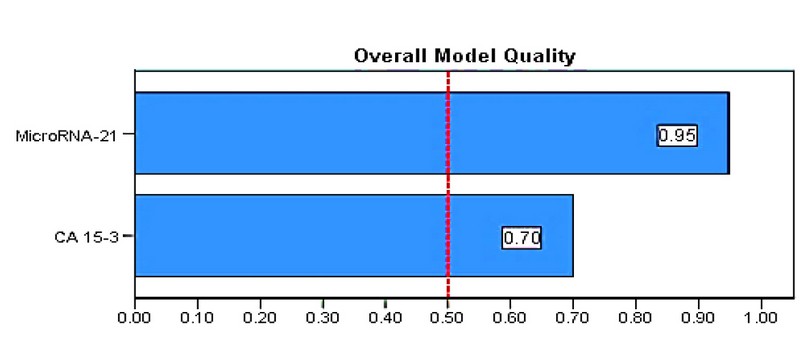
Figure 4. Chart of general measurement of good model quality samples in both studied markers.
DISCUSSION
The results of the present study show that microRNA was successfully extracted from the serum samples of the patient and control groups. Statistical analysis revealed a significant increase in miRNA-21 expression in the serum of BC patients; this was higher than in standard breast samples. This evaluation of miRNA-21 makes it act as a diagnostic indicator to discuss its role as a serum marker in BC diagnosis and treatment monitoring. This result agrees with many novel studies 10, 12.
Several studies have the same result mention the primary underlying mechanism for the connection of miRNA-21 and BC is the location of the miRNA-21 gene on chromosome 17q23.2. This region is frequently amplified in BC and correlated with high expression of miRNA-21, the miRNA expression regulated by epigenetic machinery. Hypo-methylated of CpG island in the promoter region of mature miRNA-21 sequence in BC causing up-regulation of MiRNA-21 expression 13,14.
Many studies are similar to the present result. A significant up-regulation of MiRNA-21 in the BC group as an oncogenic microRNA. This is due to its ability to promote tumor growth, invasion, angiogenesis, and metastasis by targeting and suppressing several apoptotic and tumor suppressor genes in post-transcriptional, including PDCD4, PTEN and TP53 15,16,17.
The diagnostic performance of miRNA-21 was studied by analysis (ROC curve) which showed that circulating mature miRNA-21 has high sensitivity and specificity. This made it a superior indicator of the high-risk group in the early phase of breast cancer screening and was considered an effective marker in breast cancer patients compared to the healthy control group.
The same result shown in Iraqi studies mentions the high sensitivity and specificity of relative expression of circulating miRNA-21 in the BC patients compared with healthy control group 17,18. Their agreement with the Iranian study showed higher sensitivity and specificity values for microRNA-21 19.
CA 15-3 expression on the luminal surface of the normal glandular breast secretary epithelium and its expression and secretion are increased with malignant cell transformation. A novel Iraqi study mentioned that a high CA15-3 concentration is an indicator to help physicians assess breast cancer disease progression and determine adjuvant treatment for a better outcome when CA 15.3 concentrations are elevated. During the early course of therapy, this is due to disease progression or ineffective treatments 20.
This observation result agrees with several novel Iraqi studies that found higher serum of CA 15-3 levels is more likely to have breast cancer 1,17. This high concentration level of CA15-3 is similar to several new studies making it a predictive, diagnostic and prognostic biomarker 21,22,23.
The diagnostic performance of serum CA 15-3 in the present study by ROC curve shows low sensitivity and specificity to easy detection of BC patients of newly diagnosed, with these common characteristics making it not enough used at early diagnosis of breast cancer stages.
The present study result regarding novel Iraqi summary studies shows the ROC curve yields low sensitivity of CA153, merely 22.47% 18. The same line with a new study in 2021 showed that the low value of the sensitivity of CA15-3 serum marker in BC patients was only (59.06% ) 24.
Many reports documented that CA 15-3 with low sensitivity is not recommended as a screening tool for early detection of BC and remains an important asset to monitor the efficacy of medical therapies 25.
The diagnostic value of CA15-3 is relatively low specificity, with increased serum values that can be detected in the presence of other neoplasms, such as lung, liver, pancreatic, and ovarian cancers, making it lack specificity 26.
The static analysis of diagnostic accuracy for both biomarkers was calculated, showing that the miR-21-5p marker has the highest diagnostic accuracy than the CA15-3 marker.
The statistical analyses were carried out by (ROC-AUC) curve to determine the discrimination biomarkers power of both miR-21 and CA15-3 markers by calculation of the value of area under the curve (AUC), showing that miRNA-21 has a more comprehensive and more meaningful AUC than CA 15-3.
This result agrees with the Iraqi study found high folding change expression of serum miR-21and high specificity and sensitivity has high accuracy ( 100% ) with excellent ( 100% ) Interpretation 27.
In Iran new ( ROC-AUC ) curve analyses study reported miR-21 was valuable in higher distinguishing power (higher AUCs) of early breast cancer disease and recurrent breast cancer (82% for early diagnosis and 86% for recurrent) respectively than the average healthy control group [19]. Also, it is similar to the Italian study, mentioning high miR-125 AUC was (85%) able to discriminate BC patients from healthy donors than the traditional BC biomarkers CA15-3 only (70%) and showed a high diagnostic accuracy of miRNA-125 (79%) than accuracy in CA15-3 (68%) 28.
A similar result in a study identified the type of tumor, whether malignant or not, providing a possible result in terms of AUC and accuracy in the more challenging case of breast cancer. When using augmented data sets, their area under the curve (AUC) reached (92.9%) with accuracy (96.7%) of case BC 29.
The overall model quality can be considered a "good model" when the correct prediction rate for positive responses meets the specified minimum probability. Overall, Model Quality was good model when its value was above ( 0.50 ), but a value less than ( 0.50 ) indicates the model is no better than random prediction.
According to the present quality result, the circulating miRNA-21 with high model quality was considered an efficient blood circulation sample used in molecular analysis to the diagnostic, predictive and prognostic marker of breast cancer patients than healthy controls.
The novel study has the same result mentioning tumor biomarkers are sample molecules that are measured in tissue and other body fluids, being considered efficient blood circulation samples that can predict the risk of getting cancer (predictive biomarkers) and signal early stages of cancer (diagnostic biomarkers) and thus assess the risk of cancer progression or possible response to therapy (prognostic biomarkers) 22.
CONCLUSIONS
The statistical analyses of miRNA-21 expression and CA 15-3 levels were significantly increased in the BC group compared to the control group. However, CA15-3 had a lower median concentration level (2.3 times) than miRNA-21 (5.2 times), making the miRNA-21 a superior marker for detecting the high‐risk BC group at the early BC diagnosis stage.
The ROC curve was plotted for the investigated markers, and a cut-off point was detected that miRNA-21 had higher sensitivities, specificities, diagnostic accuracy, discrimination power AUC and diagnostic overall model quality than the tumor marker (CA15-3), making the MiRNA21 a more vivid diagnostic, predictive and prognostic breast cancer marker compared to CA 15-3 biomarker.
The higher characteristics of circulating mature miRNA-21 make it a practical test and potential diagnostic indicator to compare BC patients with healthy controls. Thus, their usefulness as noninvasive markers helps minimize the unnecessary breast biopsies used for the early detection of breast cancer.
Funding: self-funding
Informed Consent Statement: "Informed consent was obtained from all subjects involved in the study."
Data Availability Statement:
https://gco.iarc.fr/today/home,
http://atlasgeneticsoncology.org/,
https://www.ncbi.nlm.nih.gov/gene .
Acknowledgments: we acknowledge any person who supports me in completing this project.
Conflicts of Interest: The authors declare no conflict of interest.
REFERENCES
1. Hussain, A. M. ; Ali, A. H. ; Mohammed, H. L. (2022). Abstract : November 2021, 501–514.
2. Alwan, N., & Shawkat, M. M. Treatment options and follow-up among Iraqi patients with breast carcinoma. European Journal of Medical and Health Sciences, (2020) 2(2).
3. Bassey, E. ; Chinemelum, B. ; Huygens, A. Review Paper BREAST CANCER – REVIEW. (2022) 11(3), 9248–9257.
4. Walbaum, B. ; Puschel, K., Medina, L. ; Merino, T. ; Camus, M. ; Razmilic, D.; Navarro, M. E.; Dominguez, F.; Cordova-Delgado, M.,; Pinto, M. P. ; Acevedo, F. ; Sánchez, C. Screen-detected breast cancer is associated with better prognosis and survival compared to self-detected/symptomatic cases in a Chilean cohort of female patients. Breast Cancer Research and Treatment, (2021) 189(2), 561–569. https://doi.org/10.1007/s10549-021-06317-1
5. Baselice, S. ; Castaldo, R., Giannatiempo, R. ; Casaretta, G. ;Franzese, M. ; Salvatore, M. ; Mirabelli, P. Impact of Breast Tumor Onset on Blood Count, Carcinoembryonic Antigen, Cancer Antigen 15-3 and Lymphoid Subpopulations Supported by Automatic Classification Approach: A Pilot Study. Cancer Control : Journal of the Moffitt Cancer Center, (2021) 28, 10732748211048612. https://doi.org/10.1177/10732748211048612
6. Ma, Y. ; Wang, H. ; Zhao, W., Li, Y.-F. ; Wang, J. ; Chen, X. ; Huang, Y. ; Wang, W. ; Wang, Y. ; Sun, S.-C. Prognostic Value of Combined Lactate Dehydrogenase, C-Reactive Protein, Cancer Antigen 153 and Cancer Antigen 125 in Metastatic Breast Cancer. Cancer Control, (2022) 29(99), 107327482110531. https://doi.org/10.1177/10732748211053150
7. Cheong, J. K. ; Tang, Y. C. ; Zhou, L. ; Cheng, H. ; Too, H. P. Advances in quantifying circulatory microRNA for early disease detection. Current Opinion in Biotechnology, (2022) 74, 256–262. https://doi.org/10.1016/j.copbio.2021.12.007
8. Yang, Z. ; Liu, Z. The emerging role of microRNAs in breast cancer. Journal of Oncology, (2020) 2020.
9. Sales, A. C. V. ; da Silva, I. I. F. G. ;Leite, M. C. B. ;Coutinho, L. L. ;Reis, R. B. A. C. ; Castoldi, A. ; Martins, D. B. G. ;Lima-Filho, J. L. ; Souto, F. O. MiRNA21 expression in the breast cancer tumor tissue is independent of neoadjuvant chemotherapy. Breast Cancer: Targets and Therapy, (2020) 12, 141–151. https://doi.org/10.2147/BCTT.S269519
10. Savitri, M. ;Bintoro, U. Y. ; Sedana, M. P. ; Diansyah, M. N.; Romadhon, P. Z. ; Amrita, P. N. A. ; Wijaya, A. Y. ; Hendrata, W. M. ; Prayogo, A. A. Circulating plasma miRNA-21 as a superior biomarker compared to CA 15-3: Assessment in healthy age matched subjects and different stage of breast cancer patients. Indonesian Biomedical Journal, (2020) 12(2), 157–164. https://doi.org/10.18585/inabj.v12i2.1142
11. SAS, J . Statistical Analysis System, v. 10.0. 2. Cary, North Carolina. USA(2012).
12. Diansyah, M. N. ; Prayogo, A. A. ;Sedana, M. P. ; Savitri, M. ; Romadhon, P. Z. ; Amrita, P. N. A. ;Wijaya, A. Y. ; Hendrata, W. M. ; Bintoro, U. Y. Early detection breast cancer: role of circulating plasma miRNA-21 expression as a potential screening biomarker. Turkish Journal of Medical Sciences, (2021) 51(2), 562–569.
13. Yao, Q. ; Chen, Y. ; Zhou, X. The roles of microRNAs in epigenetic regulation. Current Opinion in Chemical Biology,(2019) 51, 11–17.
14. Ramadan, A.. ;Hashim, M., ;Abouzid, A. ; Swellam, M. Clinical impact of PTEN methylation status as a prognostic marker for breast cancer. Journal of Genetic Engineering and Biotechnology, (2021). 19(1). https://doi.org/10.1186/s43141-021-00169-4
15. Uzuner, E. ;Ulu, G. T. ; Gürler, S. B. ; Baran, Y. The role of MiRNA in cancer: pathogenesis, diagnosis, and treatment. In miRNomics (2022). (pp. 375–422). Springer.
16. Bautista-Sánchez, D. ; Arriaga-Canon, C.; Pedroza-Torres, A., De La Rosa-Velázquez, I. A. ; González-Barrios, R. ;Contreras-Espinosa, L. ;Montiel-Manríquez, R. ;Castro-Hernández, C. ; Fragoso-Ontiveros, V. ; Álvarez-Gómez, R. M. ; Herrera, L. A. The Promising Role of miR-21 as a Cancer Biomarker and Its Importance in RNA-Based Therapeutics. In Molecular Therapy - Nucleic Acids (2020). (Vol. 20, pp. 409–420). https://doi.org/10.1016/j.omtn.2020.03.003
17. Abdulhussain, M. M. ;Hasan, N. A. ; Hussain, A. G. Interrelation of the circulating and tissue MicroRNA-21 with tissue PDCD4 expression and the invasiveness of Iraqi female breast tumors. Indian Journal of Clinical Biochemistry, (2019). 34(1), 26–38.
18. Abdulateef, S.M. ,O.K. Atalla, MQ. Al-Ani, TH. T. Mohammed, F.M. Abdulateef, O.M. Abdualmajeed , K. Mahmod. The effect of the electric shock on embryonic development and neurophysiological traits in the chick's embryo . IOP Conference Series: Earth and Environmental Science.2021, 761(1), 012090
19. Maryam, M. ;Chaleshtori, M. H. ; Ghasemi, S. ; Mokarian, F. Plasma level of mir-21 and mir-451 in primary and recurrent breast cancer patients. Breast Cancer: Targets and Therapy, (2019) 11, 293–301. https://doi.org/10.2147/BCTT.S224333
20. Abed, S. N. ; Mahdi, H. S. ; Sahib, A. S. ; Almaali, H. M. M. A. ; Al Haydar, M. ; Mohsin, K. K. Serum levels of cancer antigen 15.3 and estrogen in a samples of iraqi women with breast cancer treated with anastrazole. International Journal of Pharmaceutical Research, (2020). 12(August), 1604–1608. https://doi.org/10.31838/ijpr/2020.SP1.246
21. NERMINE H. MAHMOUD, MD, D. M. A. E. M. D. ; MOHAMMED MATAR, MD, H. H. A. M. D. Circulating MicroRNA-21 As A Promising Marker for Early Detection of Breast Cancer and Disease Progression in Egyptian Females. The Medical Journal of Cairo University, (2019) 87(June), 2491–2500. https://doi.org/10.21608/mjcu.2019.54858
22. Li, C. J. ; Chen, H. M. ; Lai, J. C. Diagnostic, Prognostic, and Predictive Biomarkers in Breast Cancer. Journal of Oncology, (2020). https://doi.org/10.1155/2020/1835691
23. Song, X. ; Liang, B. ;Wang, C. ; Shi, S. Clinical value of color Doppler ultrasound combined with serum CA153, CEA and TSGF detection in the diagnosis of breast cancer. Experimental and Therapeutic Medicine, (2020) 20(2), 1822–1828. https://doi.org/10.3892/etm.2020.8868
24. Liu, W. ; Liu, W. ;Lin, K., Liu, Y. ; Hu, H. ; Yang, L. A clinical study of serum human epididymis protein 4 (HE4) in the diagnosis of pancreatic cancer. Indian Journal of Cancer(2021).
25. Gautam, N. ; Verma, H. ; Choudhary, S. ; Kaur, S. ; Silakari, O. Functional relationship of SNP (Ala490Thr) of an epigenetic gene EZH2 results in the progression and poor survival of ER+/tamoxifen treated breast cancer patients. Journal of Genetics, (2021) 100(2). https://doi.org/10.1007/s12041-021-01327-w
26. Qiu, L. ; Weng, G. The diagnostic value of serum miR-21 in patients with ovarian cancer: a systematic review and meta-analysis. Journal of Ovarian Research, (2022) 15(1), 1–12.
27. Al-temimi, S. M. ; Al-rekabi, A. M. Serum MicroRNA-21 High Level Expression in Breast Cancer in Relation to Advance Stage.(2017) 16(1), 9–17.
28. Incoronato, M. ;Grimaldi, A. M. ;Mirabelli, P. ; Cavaliere, C. ; Parente, C. A. ; Franzese, M. ; Staibano, S. ; Ilardi, G. ; Russo, D. ; Soricelli, A., Catalano, O. A. ; Salvatore, M. Circulating miRNAs in untreated breast cancer: An exploratory multimodality morpho-functional study. Cancers, (2019) 11(6), 1–22. https://doi.org/10.3390/cancers11060876.
29. Rashid, R. ; Ali, S. Implication of Connexin 43 as a Tumor Suppressor in Pathogenesis of Breast Cancer. In Global Women's Health. (2021). IntechOpen.
Received: 20 July 2022 / Accepted: 15 October 2022 / Published:15 November 2022
Citation: Abbas R A R, Aziz I H. Study comparing the oncogenic microRNA-21-5p and the CA15-3 characteristics as an effective tumor marker in breast cancer patients from Iraq. Revis Bionatura 2022;7(4) 10. http://dx.doi.org/10.21931/RB/2022.07.04.10
